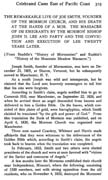
[p. 319]
THE REMARKABLE LIFE OF JOE SMITH, FOUNDER OF THE MORMON CHURCH, AND HIS DEATH AT THE HANDS OF A MOB. THE MASSACRE OF 150 EMIGRANTS BY THE MORMON BISHOP JOHN D. LEE AND PARTY AND THE CONVICTION AND EXECUTION OF LEE TWENTY YEARS LATER.
(From Beaddle's "History of Mormonism" and Rankin's "History of the Mountain Meadow Massacre.")
Joseph Smith, founder of Mormonism, was born on December 23, 1805, at Sharon, Vermont, but he subsequently moved to Manchester, N. Y.
As a youth Joseph was wild and intemperate, but he claimed that the Lord sent heavenly messengers to tell him that his sins were forgiven.
According to Smith's claim, angels notified him to go to Cumorah Hill, near Manchester, on September 22, 1826, and when he arrived there an angel descended from heaven and delivered to him a Golden Bible. On the leaves, which consisted of thin plates of gold, were hieroglyphics, which Smith claimed he translated "by the gift and power of God." From this translation the Book of Mormon was published, and on April 6, 1830, the Mormon Church was organized near Manchester.
Three men named Cowdery, Whitmer and Harris made affidavits that they were witnesses to the deliverance of the Golden Bible which, according to Smith's claim, the angels took back to heaven when the translation was completed. In February, 1833, Smith and two others were elected presidents of the church and were at once favored with "visions of the Savior and concourse of Angels."
A few months later the Mormons established their church near Independence, Missouri, where the following, consisting of 1500 members, met with strong opposition from the old residents, who on November 4, 1833, destroyed the Mormons'
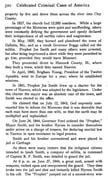
[p. 320]
property by fire and drove them across the river into Clay County.
In 1837, the church had 12,000 members. While a large percentage of the Mormons were quiet and unoffending, others were constantly defying the government and openly declared their independence of all earthly rulers and magistrates.
In May, 1839, they burned and plundered the town of Gallatin, Mo., and as a result Governor Boggs called out the militia. Prophet Joe Smith and many others were arrested, but after being imprisoned a short while they were permitted to go free, provided they would leave Missouri.
They proceeded direct to Hancock County, ILL., where they built a town, which they named Nauvoo.
In April, 1840, Brigham Young, President of the Twelve Apostles, went to Europe for a year, where he established missions. In 1841, Prophet Joe Smith drew up a charter for the town of Nauvoo, which was adopted by the legislature. Under this charter the mayor was an absolute czar of the town, and Smith was elected to the office.
He claimed that on July 12, 1843, God expressly commanded him to inform the Mormons that it was desirable that each man have more than one wife, so that the earth may be multiplied and replenished.
On June 24, 1844, Governor Ford ordered the "Prophet," Mayor Smith, and his brother Hyrum to consider themselves under arrest on a charge of treason, for declaring martial law in Nauvoo in open resistance to legal process. Smith and his brother surrendered and were placed in jail at Carthage.
As there were many rumors that the indignant citizens intended to lynch Smith, a company of militia, in command of Captain R. F. Smith, was detailed to guard the jail.
At 6 p. m. on June 27, 1844, a great mob, armed with weapons, rushed upon and overpowered the guard. They then broke into the jail and shot and instantly killed Hyrum Smith in his cell. The "Prophet" jumped out of a second-story win-
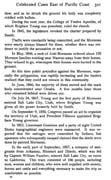
[p. 321]
dow, and as he struck the ground his body was completely riddled with bullets.
During the next year, the College of Twelve Apostles, of which Brigham Young was president, ruled the church.
In 1845, the legislature revoked the charter prepared by Smith.
Thefts were constantly being committed, and the Mormons were nearly always blamed for them, whether there was evidence to justify the accusation or not.
In May, 1846, a mob of Anti-Mormons ordered about 150 Mormon families residing near Nauvoo away from their homes. They refused to go, whereupon their houses were burned to the ground.
At this time public prejudice against the Mormons, especially the polygamists, was rapidly increasing and the leaders realized that they could not remain in this community.
In June, 1846, the majority of them moved and the main body concentrated near Omaha. A few months later those who remained behind were driven out.
On July 24, 1847, Young and the first party of Mormons entered Salt Lake City, Utah, where Brigham Young was given all the power formerly held by Smith.
On September 9, 1850, Congress passed an act to organize the territory of Utah, and President Fillmore appointed Brigham Young governor.
In 1852, Lieutenant Gunnison and a party of eight United States topographical engineers were massacred. It was reported that the outrages were committed by Indians, but apostates who subsequently escaped claimed that the deeds were done by painted Mormons.
In the early part of September, 1857, a company of emigrants from Arkansas, Missouri and Illinois, which was led by Captain William Fancher, entered Salt Lake City, en route to California. This train consisted of 166 people, including men, women and children, who were well supplied with money, horses and cattle and everything necessary to make the trip as comfortable as possible.
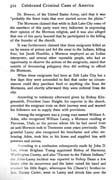
[p. 322]
Dr. Brewer, of the United States Army, said that it was "probably the finest train that ever started across the plains."
The Mormons claimed that while in Salt Lake City some of the members of this party were very indiscreet in expressing their opinion of the Mormon religion, and it was also alleged that one of this party boasted that he participated in the killing of the founder of the church.
It was furthermore claimed that these emigrants killed an ox by means of poison and fed the meat to the Indians, killing four, but Jacob Hamblin, a Mormon employed as an Indian interpreter, and several other reputable people, who had an opportunity to observe the actions of the emigrants, stated that outside of denouncing polygamy they did nothing to offend the Mormons.
When these emigrants had been at Salt Lake City but a few days they were astounded to find that under no circumstances could they purchase food or anything else from the Mormons, and shortly afterward they were ordered from the city.
According to testimony afterward given by Bishop Klingensmith, President Isaac Haight, his superior in the church, preceded the emigrant train on their journey west and warned his followers not to supply them with provisions.
Among the emigrants was a young man named William A. Aden, who recognized William Laney, a Mormon residing at Parowan, Utah, as the person whose life he had saved from an anti-Mormon mob in Tennessee some years previously. The grateful Laney also recognized his benefactor and after embracing Aden, took him to his home and supplied him with potatoes and onions.
According to a confession subsequently made by John D. Lee, whom Brigham Young appointed Bishop of Harmony, Washington County, and also "Farmer to the Pahute Indians," the Aden-Laney incident was reported to Bishop Dame a few hours after its occurrence and the latter raised his hand and crooked his little finger, whereupon his (Dame's) brother-in-law, Barney Carter, went to Laney and struck him over the
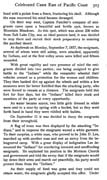
[p. 323]
head with a picket from a fence, fracturing his skull. Although the man recovered his mind became deranged.
On their way west, Captain Fancher's company of emigrants came upon a beautiful and fertile spot, known as Mountain Meadows. As this spot, which was about 200 miles from Salt Lake City, was an ideal pasture land, it was decided to stop there and recruit their stock preparatory to entering the parched desert.
At daybreak on Monday, September 7, 1857, the emigrants, several of whom were still asleep, were attacked, apparently by Indians, and at the first volley seven were killed and fifteen wounded.
With great rapidity and rare presence of mind the emigrants divided into two parties; one being assigned to give battle to the "Indians" while the remainder wheeled their vehicles around as a protection for the women and children. They then banked dirt up against the wheels and within a few moments were far better fortified than the attacking party, who were forced to remain at a distance. The emigrants held this fort for four days, but the "Indians" killed their stock and members of the party at every opportunity.
As water became scarce, two little girls dressed in white were sent to a near-by spring with a bucket, but as they went forth hand in hand they were riddled with bullets.
On September 11 it was decided to decoy the emigrants from their stronghold.
A flag of truce was then displayed by the attacking "Indians," and in response the emigrants waved a white garment. To their surprise, a white man, who proved to be John D. Lee, marched up with another man and met an envoy from the beleaguered camp. With a great display of indignation Lee denounced the "Indians" for murdering innocent and unoffending emigrants. He explained his position in the Mormon Church and government and told the envoy that if the emigrants would lay down their arms and march out peacefully, his party would protect them from the "Indians."
As their supply of food was gone and they could not obtain water, the emigrants gladly accepted this offer. Under
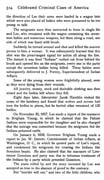
[p. 324]
the direction of Lee their arms were loaded in a wagon into which were also placed all babies who were presumed to be too young to talk.
The emigrants were then instructed to form in single file and Lee, who remained with the wagon containing the seventeen babies and numerous weapons, led them along a road, one side of which was lined with brush.
Suddenly he turned around and shot and killed the nearest person to him, a woman. It was subsequently learned that this shot was the prearranged signal for action all along the line. The instant it was fired "Indians" rushed out from behind the brush and opened fire on the emigrants, every one in the party except the seventeen babies being killed. These babies were subsequently delivered to J. Forney, Superintendent of Indian Affairs.
Some of the young women were frightfully abused, even as they were dying from their wounds.
All jewelry, money, stock and desirable clothing was then seized and the bodies left where they fell.
Eight days later, Interpreter Jacob Hamblin visited the scene of the butchery and found that wolves and ravens had torn the bodies to pieces, but he buried what remained of 120 bodies.
On November 20,1857, Lee made a report of the massacre to Brigham Young, in which he claimed that the Pahute Indians were responsible for the slaughter and he also charged that the outrage was committed because the emigrants fed the Indians poisoned cattle.
On January 6, 1858, Governor Brigham Young made a report to Jas. W. Denver, Commissioner of Indian Affairs, at Washington, D. C., in which he quoted parts of Lee's report, and condemned the emigrants for treating the Indians like ferocious beasts. He also claimed that the massacre of Lieutenant Gunnison and party was due to inhuman treatment of the Indians by a party which preceded Gunnison. The years rolled by and the story invented by Lee was accepted as true in the absence of proof to the contrary.
But "murder will out," and two of the little children, who
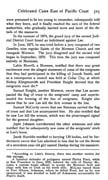
[p. 325]
were presumed to be too young to remember, subsequently told what they knew, and it finally reached the ears of the federal authorities, who gradually learned more and more of the details of the massacre.
In the summer of 1874, the grand jury of the second Judicial District Court found an indictment against Lee.
In June, 1875, he was tried before a jury composed of two Gentiles, nine regular Saints of the Mormon Church and one renegade Mormon. The jury disagreed and the second trial began in September, 1876. This time the jury was composed entirely of Mormons.
Labin Morrill, a Mormon, testified that there was great excitement over the alleged statement of some of the emigrants that they had participated in the killing of Joseph Smith, and as a consequence a council was held at Cedar City, at which Bishop Klingensmith and President Haight decreed that the emigrants must die.*
Samuel Knight, another Mormon, swore that Lee accompanied the flag of truce to the emigrants' camp and superintended the forming of the line of emigrants. Knight also swore that he saw Lee kill the first woman in the line.
Samuel McCurdy swore that one Bateman carried the flag of truce and that Lee accompanied him. He also testified that he saw Lee kill the woman, which was the prearranged signal for the general slaughter.
Jephi Johnson corroborated the other witnesses and also testified that he subsequently saw some of the emigrants' stock at Lee's home.
Jacob Hamblin testified to burying 120 bodies, and he furthermore swore that Lee admitted to him that he cut the throat of a seventeen-year-old girl named Dunlap during the massacre.
* According to Linn's history, there was another motive for this outrage.
A fanatical defender of polygamy named Parley Pratt, while in San Francisco in June, 1855, induced the wife of Hector McLean, a custom house official, to accept the Mormon faith and elope with him to Utah as his ninth wife. McLean traced them to Fort Gibson, Arkansas, where he killed Pratt, but as he was exonerated, it was decided to hold all Arkansans accountable for Pratt's death.
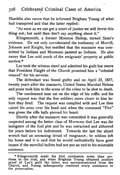
[p. 326]
Hamblin also swore that he informed Brigham Young of what had transpired and that the latter replied:
"As soon as we can get a court of justice we will ferret this thing out; but until then don't say anything about it."
Klingensmith, a former Mormon Bishop, turned State's evidence. He not only corroborated the testimony of Morrill, Johnson and Knight, but testified that the massacre was committed by Indians and Mormons painted as Indians. He also swore that Lee sold much of the emigrants' property at public auction.*
Lee took the witness stand and admitted his guilt but swore that President Haight of the Church promised him a "celestial reward" for his services.
The defendant was found guilty and on April 23, 1877, twenty years after the massacre, United States Marshal Nelson and posse took him to the scene of the crime to be shot to death.
The condemned man sat on the edge of his coffin and his only request was that the five soldiers move closer to him before they fired. The request was complied with and Lee then raised his arms over his head and when the command "Fire" was given the rifle balls pierced his heart.
Shortly after the massacre was committed it was generally suspected among the better class of Mormons that Lee was the instigator of the foul plot and he was ostracized and abhorred for years before his indictment. Towards the last the abject wretch had an unceasing dread of vengeance; he seldom left his home and it is said that he would undoubtedly have gone insane if the merciful bullets had not put an end to his miserable existence.
* Klingensmith made his first confession some time previous to the trial, and when Brigham Young obtained positive proof of Lee's guilt the latter was excommunicated from the Church, and Young subsequently rendered every assistance to the prosecution.